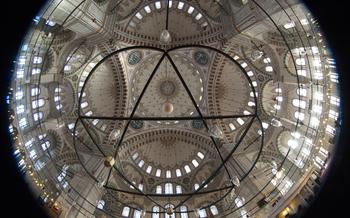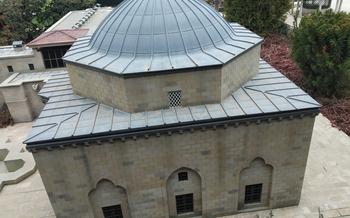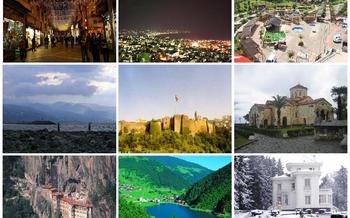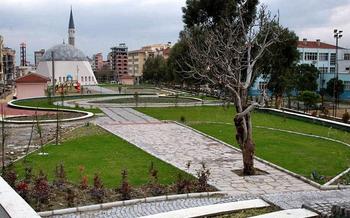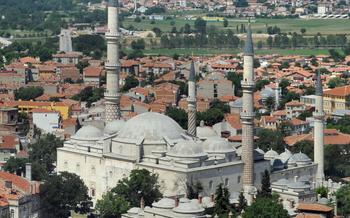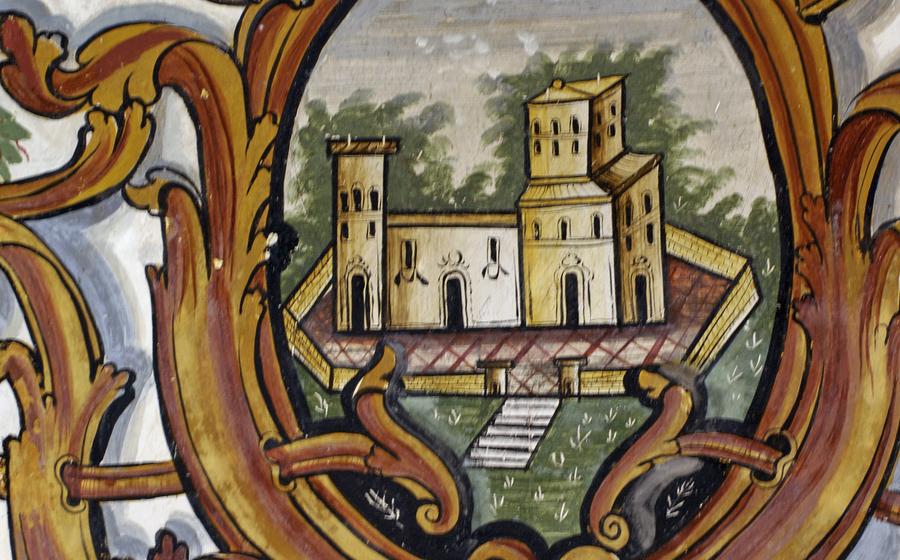
Sultan Mosque
- Sultan Mosque: A Historical Gem
- Exploring the Mosque's Interior
- Prayer Times and Visiting Hours
- Dress Code and Etiquette
- Historical Significance of the Mosque
- Sultan Mosque's Surrounding Area
- Guided Tours and Local Guides
- Sultan Mosque's Restoration and Preservation
- Sultan Mosque in Literature and Art
- Local Festivals and Events
- Sultan Mosque's Role in the Community
- Photography Tips for Visitors
- Sultan Mosque and Islamic Architecture
- Sultan Mosque for Non-Muslim Visitors
- Insider Tip: Hidden Gems Nearby
Sultan Mosque: A Historical Gem
In the heart of Manisa, Turkey, stands the magnificent Sultan Mosque, a testament to the city's rich history and architectural splendor. Built in the 16th century during the reign of Sultan Suleiman the Magnificent, this iconic mosque has become a symbol of Islamic heritage and a source of pride for the local community.
With its elegant dome, intricate tilework, and soaring minarets, the Sultan Mosque is a masterpiece of Ottoman architecture. Its design reflects the blending of traditional Islamic elements with local influences, creating a unique and harmonious structure. The mosque's cultural and religious significance extend beyond its architectural beauty, as it serves as a center for worship, education, and community gatherings.
One memorable anecdote about a visit to the Sultan Mosque involves a chance encounter with an elderly gentleman who shared his personal connection to the site. He recounted tales of his childhood, attending prayers and learning about Islamic traditions within the mosque's walls. His eyes lit up with nostalgia as he described the sense of community and spirituality that permeated the mosque's atmosphere.
Exploring the Mosque's Interior
Stepping inside the Sultan Mosque is like entering a realm of intricate artistry and spiritual devotion. The vast dome, adorned with vibrant tilework in shades of turquoise, emerald, and sapphire, is a testament to the skill of Ottoman artisans. The intricate patterns and geometric designs seem to dance and shimmer in the sunlight, creating an awe-inspiring sight.
The mihrab, a sacred niche indicating the direction of Mecca, is a masterpiece in itself. Carved from a single block of marble, it is embellished with intricate calligraphy and delicate floral motifs. The minbar, or pulpit, stands beside it, its wooden panels intricately carved with verses from the Quran.
Quranic verses and calligraphy adorn the walls of the mosque, adding to its spiritual ambiance. The harmonious blend of Arabic script and decorative motifs creates a soothing and contemplative atmosphere, inviting visitors to reflect and connect with their faith.
During my visit, I stumbled upon a hidden treasure within the mosque. In a secluded corner, I discovered a small room housing a collection of ancient manuscripts and religious artifacts. The caretaker, noticing my curiosity, kindly explained that these relics were carefully preserved to showcase the mosque's rich history and cultural heritage.
Prayer Times and Visiting Hours
The Sultan Mosque welcomes visitors during specific prayer times and visiting hours. Prayer times in Turkey generally align with the daily Islamic prayer schedule, with five prayers throughout the day. Visitors are welcome to observe prayers from a designated area of the mosque without disrupting worshippers.
To experience the mosque's serene ambiance, it is recommended to visit during non-prayer hours, typically between 9 am and 12 pm or after 2 pm. This allows for a peaceful exploration of the mosque's interior and a deeper appreciation of its architectural details.
Non-Muslim visitors are welcome to enter the mosque during visiting hours, respecting local customs and traditions. It is important to dress appropriately, covering shoulders and knees, and removing shoes before entering the prayer hall.
One memorable experience during my visit was witnessing the call to prayer (adhan) echoing throughout the city. The melodious chant, recited from the mosque's minaret, created a spiritual atmosphere that transported me to another era.
Dress Code and Etiquette
When visiting the Sultan Mosque, it is essential to dress respectfully, adhering to the local customs and religious norms. Modest clothing is recommended for both men and women, covering the shoulders and knees. Women are required to cover their heads with a headscarf or shawl, which can be borrowed from the mosque if needed.
It is also customary to remove shoes before entering the mosque as a sign of respect. Shoe racks are provided at the entrance for visitors to store their footwear. This practice helps maintain the cleanliness and sanctity of the prayer space.
Once inside the mosque, visitors are expected to be mindful of their behavior and maintain a respectful demeanor. Loud talking, laughing, or engaging in disruptive activities is considered inappropriate. It is essential to remember that the mosque is a place of worship and tranquility, and visitors should strive to preserve its sacred atmosphere.
During my visit, I witnessed a cultural faux pas when a group of tourists entered the mosque wearing shorts and tank tops. They were politely reminded by a local worshipper about the appropriate dress code, and they promptly covered up with shawls provided by the mosque. This incident highlighted the importance of respecting local customs and dressing appropriately when visiting religious sites.
Historical Significance of the Mosque
The Sultan Mosque stands as a testament to the rich history of the Ottoman Empire and its profound impact on the city of Manisa. Built during the reign of Sultan Bayezid II, this majestic structure played a pivotal role in shaping the city's religious and cultural landscape.
As a symbol of Islamic heritage in Manisa, the mosque attracted worshippers and pilgrims from far and wide. It became a focal point for religious observances, serving as a place of prayer, reflection, and spiritual guidance. The mosque's construction reflected the architectural prowess of the Ottoman Empire, showcasing intricate tilework, elegant calligraphy, and a soaring dome that dominated the cityscape.
The Sultan Mosque's historical significance is deeply intertwined with the history and identity of Manisa. It has borne witness to centuries of change, from the rise and fall of empires to the evolution of Turkish society. Locals hold the mosque in high esteem, considering it an integral part of their cultural heritage.
Anecdote:
During my visit to the mosque, I stumbled upon an elderly gentleman who shared a captivating story about his childhood. He recalled how, as a young boy, he would accompany his grandfather to the mosque for prayers. He spoke fondly of the serene atmosphere, the melodious recitation of the Quran, and the sense of community he experienced within those sacred walls. His story brought to life the enduring legacy of the Sultan Mosque, a place where generations have found solace, guidance, and a deep connection to their faith.
Sultan Mosque's Surrounding Area
The Sultan Mosque is situated in the heart of Manisa, a city teeming with historical and cultural treasures. A short stroll from the mosque, you'll find the Manisa Museum, a treasure trove of artifacts that narrate the city's rich past. Immerse yourself in the captivating exhibits, from ancient pottery to intricate textiles, that unveil Manisa's journey through the ages.
Step outside the museum and you'll be greeted by the vibrant energy of traditional Turkish markets. The air is filled with the enticing aromas of freshly baked bread, sweet pastries, and fragrant spices. Browse through an array of local delicacies, from succulent olives and dried fruits to colorful Turkish delight.
In the narrow cobblestone streets surrounding the mosque, you'll stumble upon charming cafes that beckon you to linger over a cup of aromatic Turkish coffee or a refreshing glass of tea. Take a break from your explorations and soak in the local ambiance as you watch the world go by.
My personal experience exploring the neighborhood around the Sultan Mosque was one of delightful discoveries. I stumbled upon a hidden gem tucked away in a quiet alleyway—a traditional Turkish restaurant that served mouthwatering kebabs and gözleme, a savory flatbread filled with cheese, spinach, or minced meat. The flavors were simply divine, and the warm hospitality of the owner made the experience all the more memorable.
Guided Tours and Local Guides
The Sultan Mosque offers guided tours for visitors who seek a deeper understanding of its history and cultural significance. These tours are led by knowledgeable local guides who provide insights into the mosque's architecture, religious practices, and its role in the community.
One of the main benefits of hiring a local guide is their ability to share personal anecdotes and stories related to the mosque, bringing its history to life. They can point out hidden details and explain the symbolism behind various elements of the mosque's design.
Moreover, local guides can help you navigate the mosque's interior and ensure that you observe proper etiquette. They can guide you through the prayer hall, explaining the significance of the mihrab (prayer niche) and the minbar (pulpit).
During my visit to the Sultan Mosque, I had the privilege of being guided by a local historian who shared fascinating stories about the mosque's construction and its role in the community. He explained the intricate tilework and calligraphy, pointing out hidden inscriptions that revealed the names of the mosque's builders and donors.
Whether you are a history buff, an architecture enthusiast, or simply curious about Islamic culture, a guided tour with a local guide is highly recommended. Their knowledge and insights will enhance your experience and leave you with a deeper appreciation for the Sultan Mosque.
Sultan Mosque's Restoration and Preservation
The Sultan Mosque has undergone several renovations and conservation projects throughout history, ensuring its preservation for generations to come. In the early 20th century, extensive repairs were carried out to reinforce the structure and restore its original grandeur. These efforts included strengthening the foundations, repairing the dome, and retiling the exterior.
In recent years, the mosque has benefited from ongoing maintenance and restoration work, focusing on preserving its intricate tilework, calligraphy, and architectural features. Skilled artisans and craftsmen have meticulously restored damaged sections, ensuring the mosque's beauty and integrity are maintained.
Preserving a historical site like the Sultan Mosque comes with its challenges. The mosque's age and exposure to the elements necessitate constant monitoring and care. Balancing the need for preservation with the desire to retain its authenticity is a delicate task.
As a traveler and admirer of historical landmarks, I believe preserving our heritage is essential. The Sultan Mosque stands as a testament to the skill and artistry of its creators and holds immense cultural and religious significance. Ensuring its preservation allows future generations to appreciate and learn from this architectural masterpiece.
Sultan Mosque in Literature and Art
Beyond its religious significance, the Sultan Mosque has inspired numerous artistic and literary creations. Turkish literature is replete with references to the mosque, often serving as a backdrop for poignant stories and historical narratives. In the novel "The Time Regulation Institute", the mosque's imposing presence looms over the protagonist's journey of self-discovery.
Artistic representations of the mosque are equally captivating. Paintings and photographs capture its architectural grandeur from diverse perspectives. Local artists have immortalized the mosque's beauty in vibrant canvases, while photographers have documented its serene ambiance and intricate details. The mosque's cultural significance extends beyond its religious function, becoming a symbol of Manisa's rich artistic heritage.
In a delightful anecdote, a renowned Turkish poet once penned a sonnet inspired by the Sultan Mosque. Struck by its ethereal beauty, he wove words that danced around the mosque's domes and minarets, capturing its essence in a lyrical masterpiece. This anecdote underscores the mosque's profound impact on the creative minds of Turkey.
Local Festivals and Events
The Sultan Mosque is not only a place of worship but also a hub for cultural and community events. Throughout the year, various festivals and gatherings are held at the mosque, offering visitors a chance to experience Turkish traditions and festivities firsthand.
One of the most significant events is the annual Mevlid-i Nebi, which commemorates the birth of Prophet Muhammad. During this festival, the mosque is decorated with colorful lights and flowers, and special prayers and recitations are held. Visitors can also enjoy traditional music, dance performances, and food stalls set up in the mosque's courtyard.
Other notable events include the Laylat al-Qadr, the Night of Power, which is observed during the holy month of Ramadan. On this night, Muslims stay up late to pray and seek forgiveness, and the mosque remains open throughout the night for worshippers.
For those interested in Turkish culture, the mosque also hosts regular cultural events, such as poetry readings, art exhibitions, and traditional handicraft workshops. These events provide a platform for local artists and artisans to showcase their work and share their cultural heritage with visitors.
Attending a festival or event at the Sultan Mosque is a fantastic way to immerse yourself in Turkish culture and traditions, meet new people, and gain a deeper understanding of the country's diverse religious and cultural heritage.
Sultan Mosque's Role in the Community
Beyond its religious significance, the Sultan Mosque serves as a vibrant hub for the local community. It is not just a place of worship but also a center for religious education, community outreach programs, and social gatherings. The mosque's spacious courtyard and interior provide a welcoming space for people to come together, exchange ideas, and strengthen their bonds.
One particularly memorable event I witnessed during my visit was a community iftar, a traditional meal to break the fast during the holy month of Ramadan. The entire courtyard was bustling with activity as families and friends gathered to share a meal and celebrate the spirit of togetherness. The atmosphere was filled with laughter, camaraderie, and a sense of unity that transcended religious differences.
The Sultan Mosque's role in fostering social cohesion is undeniable. It is a place where people from all walks of life come together to celebrate their shared heritage, traditions, and values. It is a symbol of the city's vibrant cultural fabric and a testament to the power of faith in bringing people together.
Photography Tips for Visitors
The Sultan Mosque's architectural grandeur and intricate details make it a photographer's paradise. To capture the mosque's essence, position yourself at an angle that showcases its towering minarets and the harmonious blend of domes and arches. Experiment with different perspectives to highlight unique features like the intricate tilework and calligraphy.
Choose the right time of day for optimal lighting. The warm glow of sunrise or sunset casts a magical hue on the mosque's facade, creating stunning photo opportunities. During the day, the bright sunlight provides clear and crisp shots, allowing you to capture every detail.
Remember to be respectful when taking photos, especially during prayer times. Avoid using flash photography or causing any disruption to worshippers. Ask permission if you wish to photograph individuals, and always maintain a polite and considerate demeanor.
As a photography enthusiast, I've spent hours capturing the Sultan Mosque's beauty from every angle. One of my favorite shots is a panoramic view taken from the nearby hilltop, where the mosque stands majestically against the backdrop of the city skyline. The golden domes and minarets against the vibrant blue sky create a truly breathtaking image.
Sultan Mosque and Islamic Architecture
The Sultan Mosque is a prime example of Ottoman architecture, a style that flourished during the Ottoman Empire from the 13th to the 20th century. It shares striking similarities with other renowned Ottoman mosques, such as the Süleymaniye Mosque in Istanbul and the Selimiye Mosque in Edirne. All three mosques feature grand domes, intricate tilework, and soaring minarets, reflecting the empire's architectural prowess.
Comparing the Sultan Mosque with these architectural marvels reveals a common thread of grandeur and harmony. The vast domes, adorned with intricate patterns and Quranic verses, create a sense of awe and spirituality. The slender minarets, reaching towards the sky, symbolize the connection between heaven and earth. The use of natural light, filtering through the stained-glass windows, illuminates the interiors and enhances the beauty of the tilework.
The Sultan Mosque also showcases the evolution of Islamic architecture over time. While it shares similarities with earlier Seljuk mosques, it incorporates Renaissance influences, such as the use of semi-circular arches and decorative elements. This blend of architectural styles reflects the cultural and historical influences that shaped the Ottoman Empire.
Personally, I find the Sultan Mosque's architectural details particularly captivating. The intricate tilework, featuring floral motifs and geometric designs, is a testament to the skill and artistry of Ottoman craftsmen. The harmonious proportions of the mosque, with its central dome flanked by four smaller domes, create a sense of balance and symmetry that is both pleasing to the eye and uplifting to the soul.
Sultan Mosque for Non-Muslim Visitors
The Sultan Mosque extends a warm welcome to non-Muslim visitors, offering an opportunity for interfaith dialogue and cultural exchange. This historic site is a testament to the rich Islamic heritage of Manisa, and visitors are encouraged to learn about the mosque's significance and architecture. Respecting local customs and traditions is essential when visiting religious sites. Dressing modestly, removing shoes before entering the mosque, and maintaining a respectful demeanor are all important gestures of respect.
During my visit, I had the privilege of interacting with locals who were eager to share their knowledge about the mosque and their city. They spoke passionately about the mosque's history and its role in the community. I felt a sense of warmth and inclusivity as I engaged in conversations with the locals, fostering a deeper understanding of their culture and way of life.
Insider Tip: Hidden Gems Nearby
Beyond the Sultan Mosque itself, Manisa offers hidden gems that are waiting to be explored. For a breathtaking panoramic view of the mosque and the city, climb up to the ancient Byzantine castle, which offers a unique perspective. For a taste of authentic Turkish cuisine, venture into the side streets near the mosque, where you'll find hole-in-the-wall restaurants serving delicious local dishes.
If you're interested in history, explore the Manisa Museum, which houses a collection of artifacts from the city's rich past. Don't miss the opportunity to visit the nearby Muradiye Mosque, another architectural masterpiece from the Ottoman era. With its intricate tilework and serene atmosphere, it's a hidden gem that is often overlooked by tourists.
For a truly immersive experience, I recommend staying in one of the traditional Turkish guesthouses in the neighborhood. This is a great way to interact with locals, learn about their culture, and get insider tips on hidden gems that are not commonly known to tourists.




